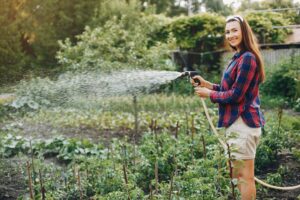 Choosing the most efficient and appropriate irrigation system for our garden or orchard is very important. It must fulfill the necessary functions for the best care of plants and saving Water.
Choosing the most efficient and appropriate irrigation system for our garden or orchard is very important. It must fulfill the necessary functions for the best care of plants and saving Water.
Currently, the most efficient irrigation systems in gardening are the following:
Efficient Drip Irrigation
The most effective irrigation system to save Water is drip irrigation. It can be installed on the surface or buried. It is a system based on a set of pipes with small, interconnected perforations that distribute Water continuously through the pores (drop by drop). This system achieves an efficiency of 90-95% in water use.
It is a very easy system to install; the pipes are located right at the foot of the plants. Thanks to the holes, the waterfall is at a speed that is generally previously programmed, allowing it to come into direct contact with the roots of the plants without evaporating or filtering, so it is not wasted.
Efficient Irrigation By Exudation
It is an irrigation system very similar to drip irrigation. It consists of pipes made of textile material that are porous and exude Water uniformly over their entire surface. In this way, a continuous line of moisture is formed, making this irrigation system very suitable for in-line plant irrigation and sandy soils.
Thanks to this efficient irrigation system, large amounts of Water are saved since it is optimized to the maximum by not evaporating. It can be used on the surface or buried, although underground is when more optimal irrigation is achieved for the roots of the plants.
Efficient Sprinkler Irrigation
Sprinkler irrigation is one of the most efficient irrigation systems. It is usually used on large surfaces and is based on the application of Water in the form of rain on the surface to be watered (very similar to how plants would obtain Water naturally). The Water is conveyed under pressure through a network of pipes until it reaches the sprinklers responsible for dispersing it through rotating movements.
 This irrigation system offers a long, useful life and allows for greater distance water distribution and automation. You can also adjust the power and orientation of the irrigation.
This irrigation system offers a long, useful life and allows for greater distance water distribution and automation. You can also adjust the power and orientation of the irrigation.
Irrigation Programmers For Efficient Irrigation
Irrigation programmers are accessories that connect to a water outlet to allow the days, hours, and duration of irrigation to be programmed. They are very useful for when we are on vacation and cannot take care of watering, but they are also useful for saving time, money, and, above all, Water. Installing an irrigation programmer will help us save a large volume of Water by adjusting the exact irrigation time without wasting a minute of irrigation.
Surface Irrigation Programmers
Simple and flexible. They are installed directly on the tap and are responsible for watering when you tell them to. There are different models for each irrigation need.
Buried Irrigation Programmer
This system is completely invisible on the surface, thanks to underground pipes. With a multi-channel in-ground irrigation controller, each area is supplied with Water at the right time and frequency without you having to keep an eye on it.…

 Installing a buried irrigation system in our garden offers us numerous advantages. We would all like a lustrous lawn with a desirable appearance and a garden overflowing with flowers and plants. Efficient irrigation systems allow us to achieve this and much more.
Installing a buried irrigation system in our garden offers us numerous advantages. We would all like a lustrous lawn with a desirable appearance and a garden overflowing with flowers and plants. Efficient irrigation systems allow us to achieve this and much more. Filter Water To The Roots Of The Grass
Filter Water To The Roots Of The Grass